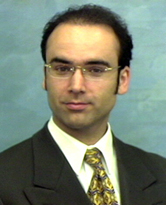 |
Ali Khoynezhad, M.D. |
The April 14 procedure was performed by a team of endovascular surgeons and was led by Ali Khoynezhad, M.D., a cardiothoracic and endovascular surgeon at The Nebraska Medical Center and assistant professor of cardiovascular and thoracic surgery at UNMC.
“The operation went well. I am very pleased,” Dr. Khoynezhad said. “It was truly a collaborative effort. Everyone did a great job.”
Within days, the patient, an 84-year-old Omaha woman, was out of the hospital and recovering at home. She’d been diagnosed just three weeks before surgery. A sudden onset of chest and back pain were symptoms of a dangerous condition — an ulcer that had developed on a pre-existing aneurysm. Part of her aorta had weakened and become enlarged. Within that aneurysm, a small hole in the wall of the artery started to bleed.
Medications to lower the patient’s blood pressure and calm her heart rate did not stop the life-threatening bleeding around the aorta. Her team of cardiac and vascular physicians quickly determined she would need this specialized procedure.
“Not everyone is a candidate for endovascular repair,” Dr. Khoynezhad said. “But compared to traditional open surgery, the endovascular technique offers a lot of benefits for patients. It’s not nearly as stressful on their bodies and recovery time is much faster.”
The minimally invasive approach involves making an incision in the groin. A catheter is inserted into the leg arteries. Dr. Khoynezhad and his team then carefully guide the catheter, which carries a small endovascular graft, through the abdomen and into the chest. Once positioned inside the affected part of the aorta, the endovascular graft is released and gently expands to become a perfect fit.
The graft remains in the aorta permanently, preventing blood flow to the aneurysm and in this patient’s case, also the ulcer. The procedure takes about two to three hours making it shorter than traditional, open surgery, which requires a large chest incision.
“In a recently published U.S. study, the patients undergoing endovascular repair for thoracic aortic aneurysm had much lower morbidity and mortality compared to the patients undergoing open repair,” Dr. Khoynezhad said.
Other benefits include significantly lower blood loss during the operation and a shorter recovery time.
“We’re pleased to offer this option to patients who otherwise might not have a treatment choice,” Dr. Khoynezhad said. “We have gathered an experienced team consisting of endovascular and cardiothoracic surgeons that enable us to offer this life-saving and minimally invasive procedure to our community. And I want to share this achievement with my co-surgeons and endovascular colleagues Dr. Jason Johanning and Dr. Iraklis Pipinos.”
Thoracic aortic aneurysms are diagnosed in approximately 15,000 people each year, but the actual number of those affected may be much higher. Many times the condition goes undiagnosed due to a lack of symptoms. Risk factors include diabetes, heart disease, smoking, high blood pressure and a family history of thoracic aortic aneurysms.
Endovascular repair is a relatively new procedure for the treatment of thoracic aortic aneurysms and ulcers. Before joining The Nebraska Medical Center and UNMC, Dr. Khoynezhad had performed the technique on more than two dozen patients.
The Nebraska Medical Center is the only facility in Omaha — and just one of two hospitals in the state — currently offering this form of minimally invasive endovascular repair.